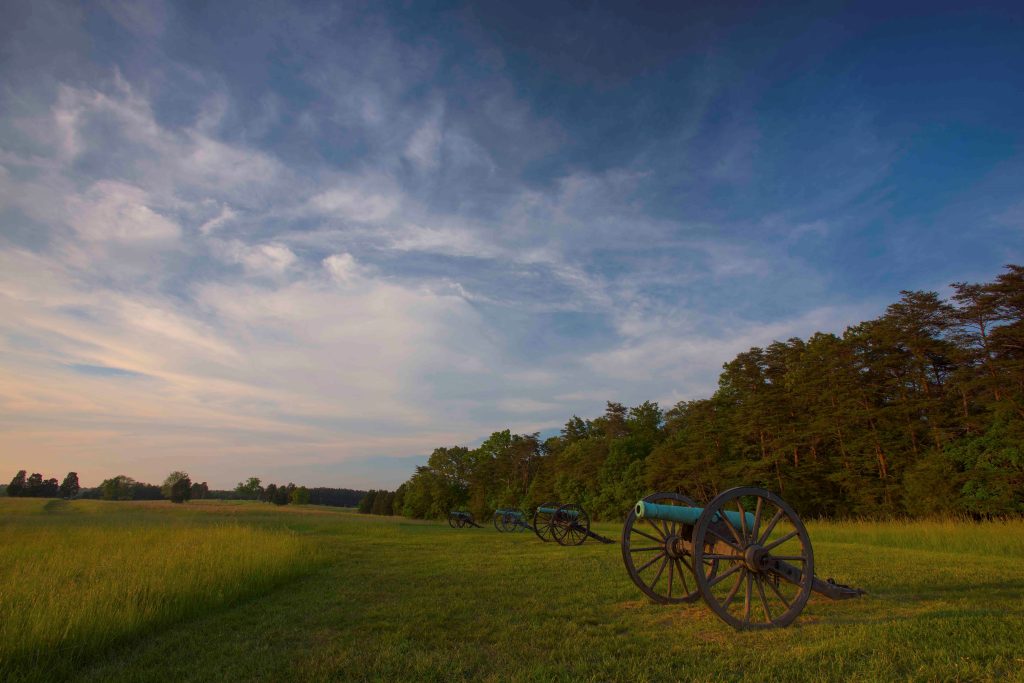A Thousand Words a Battle: Manassas – Henry House Hill
Henry House Hill, Battle of First Manassas
July 21, 1861

On July 20, 1861, tall, bearded Private Arthur Alcock walked the makeshift campgrounds of the 11th New York Fire Zouaves at Centerville. He had arrived about 10:00 PM after obtaining hospital supplies at Alexandria for the regimental surgeon, Dr. Charles Gray. Alcock visited the officers of the different units, getting a cup of coffee and a roasted potato from Captain Michael Tagan of Company D along with some good conversation from the sleepless men. Each one knew that the next day would bring a battle, the first one for the Fire Zouaves. The late Colonel Elmer Ellsworth’s “bespangled sons of Mars,” now weary, footsore, and hungry, contemplated their immediate future.
Lieutenant Daniel Diver, who did not know that he was enjoying his last night alive, accompanied Alcock on his ramble. The two men discussed the troops’ condition, commenting on their good spirits, “in view of the expected fight” the next day. In Alcock’s journal, written during his imprisonment in Richmond after the First Battle of Bull Run, “… poor Diver said to me, ‘Many a one of us will be cold tomorrow night.’ Who will say that coming events do not cast their shadows before?”[1]
The next day, about 1:30 in the afternoon, Ellsworth’s Fire Zouaves were on the field of battle, but not everyone was glad to see the red-shirted volunteers. Union Brigadier General Irvin McDowell appeared to have the battle going his way. Matthews Hill had been under Federal control since noon, but McDowell realized that it would take more than an artillery duel to clear the field at the Henry House. He would need to move the Federal artillery closer, and back it with infantry. He ordered his Chief of Artillery, Major William Barry, to direct Captain Charles Griffin and Captain James B. Ricketts to move their eleven guns across Young’s Branch Valley and up to the Henry Hill field. Both men immediately protested, unsure of adequate infantry support. Captain Griffin suggested to Major Barry that the infantry go ahead, get into position on the hill, and then have the guns come up behind them. At that point, the infantry could fall back. Barry assured both captains that orders had already been given for the 11th New York Fire Zouaves to follow them. Griffin, an Army regular, had little confidence in the ability of the flashy, volunteer Zouaves to perform under fire. Barry, who had no intention of changing his commander’s orders, replied, “Yes, they will. At any rate, it is General McDowell’s order to go there.”[2]
Griffin was not impressed. “I will go, but mark my words, they will not support us.”[3] Despite questions, McDowell’s orders stood. Griffin’s three 10-pounder Parrott guns and two 12-pound howitzers were moved south along Sudley Road, while Ricketts turned his guns off the road and on to the field at Henry Hill.
Despite numerous delays and confusion, McDowell still assumed that his battle was nearly won. At about 2:00, just as Ricketts placed his six 10-pounder Parrott guns south of the Henry House, Confederate sharpshooters inside the Henry House began to fire on the Union gun crews.[4] While Captain Ricketts was clearing out Confederate sharpshooters, Captain Griffin brought his five guns on the field, placing them north of the Henry House and to Ricketts’s left. His movement gave the Union a total of eleven guns to face the Confederacy’s thirteen. Major William F. Barry, a West Point-trained officer, rode to the Fire Zouaves’ line to personally lead them to their position, to the right of the eleven guns now being unlimbered. Companies A and H were detached to act as a reserve in the rear. Private Metcalf wrote:
Behind us in the valley, the 14th Brooklyn were drawn up in line and were resting. Oh, if we could but get some rest, just five minutes, to catch one good long breath, —one moment to get a sip of water. . . . No, not for us. Up rode an officer, sword in hand, ere we had hardly halted. “Colonel,” he shouted. ”the General [Heintzelman] has decided to put you right into it. Let the colors advance ten paces. Detail two of your companies as a reserve. Dress on your colors.” ‘Twas done. ”Come on boys, and show them what New York can do!” [5]
And with that, Ellsworth’s pet lambs were led to the slaughter.
The Union loss at Manassas/First Bull Run set the tone for a long four years of war. Never again were the “boys of ‘61” so confident, so devil may care. The First Battle of Bull Run cost about 3,000 Union casualties, compared with 1,750 for the Confederates. These results sent northerners who had expected a quick, decisive victory reeling, and gave southerners a false hope that they could pull off a swift, decisive victory.[6]
— Meg Groeling
[1] Brian C. Pohanka, Patrick A. Schroeder, With the 11th New York Fire Zouaves in Camp, Battle, and Prison: The Narrative of Private Arthur O’Neil Alcock in the New York Atlas and Leader, (Lynchburg, VA: Schroeder Publications, 2011), 185.
[2] 37th Congress, 3rd Session, House of Representatives, Report of the Joint Committee on the Conduct of the War: Bull Run, Ball’s Bluff, (Washington: U. S. Government Printing Office, 1863), 168-169.
[3] Ibid.
[4] Bradley M. Gottfried, The Maps of First Bull Run: An Atlas of the First Bull Run (Manassas) Campaign, including the Battle of Ball’s Bluff, June-October 1861, (California: Savas Beatie, 2009), 44.
[5] Ibid.
[6] https://www.history.com/topics/american-civil-war/first-battle-of-bull-run
Nice to see the writing of Meg here.
We really miss her around here.
Great article! I like the weaving of the personal experiences with the military aspects of the actions.